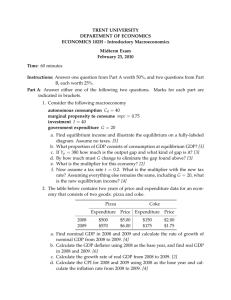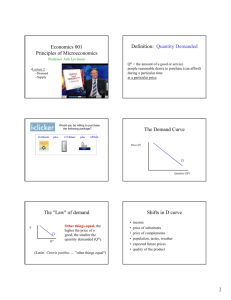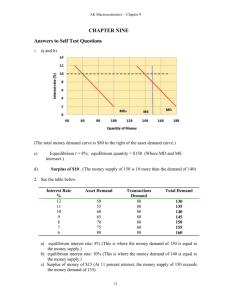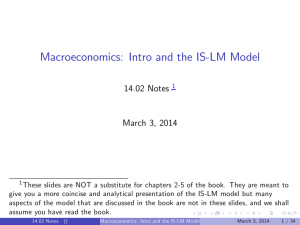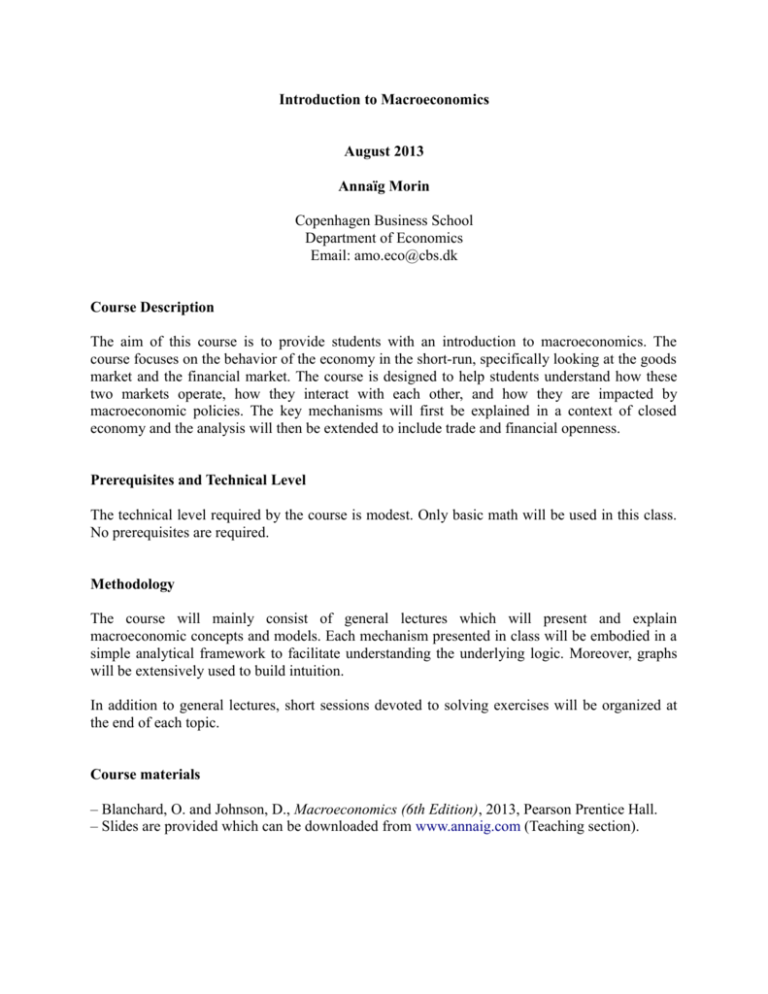
Introduction to Macroeconomics
August 2013
Annaïg Morin
Copenhagen Business School
Department of Economics
Email: amo.eco@cbs.dk
Course Description
The aim of this course is to provide students with an introduction to macroeconomics. The
course focuses on the behavior of the economy in the short-run, specifically looking at the goods
market and the financial market. The course is designed to help students understand how these
two markets operate, how they interact with each other, and how they are impacted by
macroeconomic policies. The key mechanisms will first be explained in a context of closed
economy and the analysis will then be extended to include trade and financial openness.
Prerequisites and Technical Level
The technical level required by the course is modest. Only basic math will be used in this class.
No prerequisites are required.
Methodology
The course will mainly consist of general lectures which will present and explain
macroeconomic concepts and models. Each mechanism presented in class will be embodied in a
simple analytical framework to facilitate understanding the underlying logic. Moreover, graphs
will be extensively used to build intuition.
In addition to general lectures, short sessions devoted to solving exercises will be organized at
the end of each topic.
Course materials
– Blanchard, O. and Johnson, D., Macroeconomics (6th Edition), 2013, Pearson Prentice Hall.
– Slides are provided which can be downloaded from www.annaig.com (Teaching section).
Content
The course consists of 5 key lecture topics.
TOPIC 1: Introduction to Macroeconomics, Definitions and Measurement
Readings:
• Slides
• Blanchard Chapter 2
Outline:
Definition and Measurement of GDP, GDP vs. GNP, Nominal vs. Real GDP, HDI, Consumer
Price Index and GDP deflator, Business Cycles, Procyclical vs. Countercyclical Variables,
Unemployment, Inflation.
TOPIC 2: The Goods Market
Readings:
• Slides
• Blanchard Chapter 3
Outline:
Determinants of the Demand for Goods, Equilibrium on the Goods Market, Shifts in Demand,
Multiplier.
TOPIC 3: The Financial Market
Readings:
• Slides
• Blanchard Chapter 4
Outline:
Demand for Money, Supply of Money, Determination of the Interest Rate, Shifts in the Money
Demand, Monetary Policy (Open-Market Operations),
TOPIC 4: The IS-LM Model: the Goods and Financial Markets
Readings:
• Slides
• Blanchard Chapter 5
Outline:
IS Curve, Shifts of the IS Curve, LM Curve, Shifts of the LM Curve, The IS-LM Model, Fiscal
Policy, Monetary Policy, Policy Mix.
TOPIC 5: Trade and Financial Openness.
Readings:
• Slides
• Blanchard Chapters 18, 19 and 20
Outline:
Balance of Payment, Trade Balance, Nominal and Real Exchange Rate, Determinants of Imports,
Determinants of Exports, Domestic and Foreign Assets, Interest Rate and Exchange Rate,
Interest Parity Condition, Depreciation, Marshall-Lerner Condition, the J-Curve, the IS-LM
Model in Open Economy, Fiscal and Monetary Policies, Fixed vs. Flexible Exchange Rate.
Schedule
Date
Start
End
Room
19.08.2013
8h55
12h35
SP213
20.08.2013
8h55
12h35
SPs08 Nykredit Aud.
21.08.2013
8h55
12h35
SPs05 KPMG Aud.
22.08.2013
8h55
12h35
SP205 Nordea Aud.
23.08.2013
8h55
12h35
SP208
Detailed road map
TOPIC 1: Introduction to Macroeconomics, Definitions and Measurement
1. Aggregate output
1.1.
National accounts
1.2.
GDP vs. GNP
1.3.
Nominal vs. Real GDP
1.4.
PPP adjusted GDP
2. HDI
3. Unemployment rate
3.1.
Definition
3.2.
Who are the unemployed?
3.3.
Why to look at the UR?
4. Inflation rate
4.1.
How to define the price level?
4.1.1. GDP deflator
4.1.2. CPI
4.2.
Evolution of the inflation rate
5. Trend and Business cycle
5.1.
GDP
5.2.
Cyclical properties
5.2.1. Unemployment
5.2.2. Employment
5.2.3. Inflation
5.2.4. Imports
5.2.5. Pro/countercyclical
TOPIC 2: The Goods Market and the IS Curve
1. Demand for goods
1.1.
Components
1.1.1. Consumption
1.1.2. Investment
1.1.3. Government spending
2. Equilibrium in the goods market
3. Changes of the equilibrium
TOPIC 3: The Financial Market and the LM Curve
1. Demand for money
1.1.
What is money?
1.2.
Demand for money : Equation
1.3.
Increase in nominal income
2. Supply of money
2.1.
Supply of money - What do banks and the central bank do?
2.2.
Supply of money - Central bank money and money
3. Equilibrium: Interest rate
4. How to change the interest rate?
TOPIC 4: The IS-LM Model: the Goods and Financial Markets
1. The goods market
1.1.
What we remember from Topic 2
1.2.
Investment
1.3.
Determining output
1.4.
IS relation
1.5.
Shifts of the IS curve
2. The financial market
2.1.
The LM relation
2.2.
Shifts of the LM curve
3. The IS-LM model
3.1.
An equilibrium concept
3.2.
Fiscal policy
3.3.
Monetary policy
3.4.
Fiscal and monetary policies
3.5.
Policy mix
TOPIC 5: Trade and Financial Openness.
1. Two concepts to better understand openness
1.1.
The balance of payments
1.2.
Nominal and real exchange rates
2. The goods market in an open economy
2.1.
Determination of the equilibrium
2.1.1. The demand for domestic goods
2.1.2. The equilibrium
2.2.
Changes in demand
2.3.
Depreciation
3. IS-LM in an open economy
3.1.
The goods market
3.2.
The financial market
3.3.
The goods and financial markets together: the open IS-LM model
3.4.
Effects of policy




